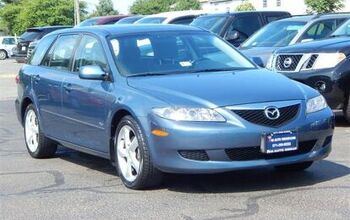Crapwagon Outtake: GM's Forgotten Wagon
Not long ago, seemingly off-the-cuff comments by Mark Reuss, GM’s chief “car guy”, got everyone in a tizzy. Reuss lamented the lack of affordable station wagons on the market today, and suggested that GM ought to start offering one in the near future. The comments, of course, came at the Detroit Auto Show’s, and Reuss, who certainly has had ample media training, had nothing to lose by throwing a bone to the assembled enthusiast media, who are uniformly pro-wagon, no matter how poor of a business case the wagon in question may be.
From the way Reuss spoke, you’d think that GM hadn’t offered a proper affordable wagon since the last of the full-size B-Body wagons rolled off the line in 1995. It turns out there was one more that had escaped many people’s imagination. I can only assume that the Malibu Maxx had been collectively blotted out of our memories in the post-bankruptcy era. Like the Saturn Astra and L-Series, the Malibu Maxx was another ill-fated experiemnt in rebranding a European offering as something wholly American.
The Maxx was essentially an Opel Signum with a bowtie – the Signum being the hatch/pseudo-wagon variant of the Opel Vectra. In the run-up to its launch, the Signum was touted by the famously jingoistic UK motoring press as a new kind of “executive car” (their term for a near-luxury sedan). To nobody’s surprise, the Signum was a flop – fleet customers stuck with the sedan and families remained with the “estate” (what we’d consider a traditional wagon). The Signum died quietly after a few years on the market.
The Maxx never achieved a lot of traction in the North American marketplace either, despite the presence of a hot SS version offering a 3.9L 240 horsepower V6 engine. Compared to the current crop of GM wagons – whether it’s the Cruze, the Astra estate or the Commodore station wagon – the Maxx was a crude, odd-looking version of a rather uncompetitive mid-size car. Unfortunately, I am not sure that any of the three modern wagons would sell in greater quantities than the Maxx, even though they’re vastly superior.
Reuss may be a car guy at heart, but he also knows how to manipulate the media, and nothing gets the hacks going like talk of a new wagon. In the mean time, you can still buy a GM wagon. A Maxx will run you about $3,000, and you’re sure to be the only one on your block.
More by Derek Kreindler
Latest Car Reviews
Read moreLatest Product Reviews
Read moreRecent Comments
- Dale Quelle surprise.
- 3SpeedAutomatic Nice looking, but IIRC, there was an issue with these engines where a knock would develop. That may account for the very low milage. 🚗🚗🚗
- Redapple2 Used to watch F 1 a great deal. Now? F1 Random thoughts:1 Silly rules bug me. Must use 2 types of tire. Cant refuel. Drag reduction can only be used in certain areas of the track and only if you are so close to the car in front.2 Passing is rare. Pole sitter wins a high % of the time.3 A new team can only start in F1 if they get the blessing of the overlords. Evil gm Vampire was barred. How about this. Anybody with a car that meets the construction rules can try. If your speed qualifies and you pay the entry fee. You re in. So is anybody else. 4 I tune in for Martin Brundle's grid walk. In my life, it s must see tv. But he is often bumped or cancelled. Grid walk takes place 1 out of 3 or 4 races.5 So, because of this utter bull sheet and other points, I ve migrated to IMSA and MotoGP. I might catch a summary on the youtube.
- Redapple2 I retract my comments and apologize.
- Flashindapan I always thought these look nice. I was working at a Land Rover dealership at the time the LR3 came out and we were all impressed how much better it was then the Discovery in just about every measurable way.


































Comments
Join the conversation
had I known this thread would be so popular, and full of irrelevancy, I never would have checked to receive posts. please stop already!
A guy I used to work with drives a Maxx, and it's been nearly perfect in the 10 years he's had it since his wife bought it just before they got engaged. It's only issue has been the stereo has twice decided to gobble up a CD and refused to play it, or spit it out. It just sits there. After a couple of days with the stereo in "limbo", it comes to life and plays the CD, or lets you eject it. The stereo was swapped out under warranty the first time, and the second time he just went and put an aftermarket head unit in it.